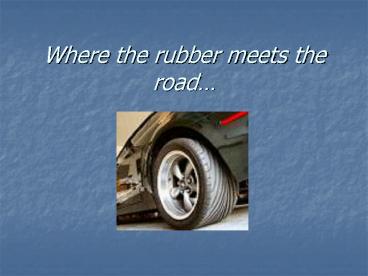Where the rubber meets the road - PowerPoint PPT Presentation
1 / 11
Title:
Where the rubber meets the road
Description:
Tires are one of the most important safety components of your car. ... on a placard on the door jamb of your vehicle, driver's door or glove box. ... – PowerPoint PPT presentation
Number of Views:30
Avg rating:3.0/5.0
Title: Where the rubber meets the road
1
Where the rubber meets the road
2
Your cars tires
- The tires on your vehicle directly affect the way
it turns, stops and grips. - Tires are one of the most important safety
components of your car. Check them frequently for
proper inflation and wear.
3
Tire Pressure
- Proper tire inflation is essential to keeping you
safe and preventing excessive wear. - On newer vehicles, the recommended pressure is
written on a placard on the door jamb of your
vehicle, drivers door or glove box. DO NOT USE
THE MAXIMUM INFLATION PRESSURE FROM THE SIDES OF
YOUR TIRES!
4
- Under-inflation degrades your cars response,
increases tread wear, lowers fuel economy and
reduces wet traction. - Don't eyeball your tires -- use a pressure gauge.
- Can you tell which tire is under-inflated?
5
- Over-inflated tires can be damaged more easily on
potholes and lead to irregular wear. - Check every week, and before trips.
- Check the air pressure when the tires are cold
(in the morning before the vehicle is driven).
6
Tire Wear
- Inspect your tires periodically and measure the
amount of tread. Too little tread means less
traction, especially when roads are slippery. - A good rule of thumb is to insert a penny into
the tread, with Lincoln's image head-first. If
the top of Lincoln's head is in the groove, you
still have enough (2/32 which is the minimum
allowed in most states).
7
Tire Wear
- Modern tires have "warning bars" that appear
across the tire tread when it is time for
replacement. - Always bear in mind, that when tires are down to
2/32 of tread depth, stopping distances can
increase dramatically. It can take worn tires up
to twice the distance to stop in the rain as
compared to new tires.
8
Tire Rotation
- Rotate your tires every 3,000 to 5,000 miles,
unless the owner's manual recommends a different
interval. - A good rule of thumb is to rotate whenever you
have your oil changed.
9
Tire Rotation
- A D
- B E
- C
- On front-wheel drive cars, rotate the tires as in
figure A or the alternate pattern B. - On rear-wheel or four-wheel drive cars, rotate as
in figure C or the alternate pattern B. - If your car has directional wheels or tires,
rotate as shown in D. - If your car has non-directional tires that are a
different size from front to rear, rotate as in E.
10
Replacing Tires
- If your tires have a lot of remaining tread
depth, but you need to replace one flat tire, you
should replace it with a tire that exactly
matches the others. Select a replacement tire of
the same brand, size, load index and speed
rating. While there may be a less expensive tire
available, its tread design and specifications
may be different. - If two of your tires have a lot of remaining
tread depth, but you need to replace the other
two because they were damaged or have worn out,
you should replace them with a pair of tires that
come as close as possible to matching your
existing tires. While identical new tires are
desirable, others of the same size and type can
also provide good results. New tires should be
installed on the rear axle.
11
Other Tips
- Have your vehicles alignment checked, especially
if your car is pulling or your tires are showing
uneven wear. Note that a shudder or vibration in
the steering wheel may be a tire out of balance
anD not necessarily an alignment problem. - If you are towing a trailer, remember that some
of the weight of the trailer IS transferred to
your vehicle and can make stopping distances
longer.































